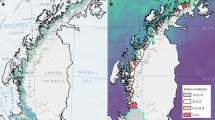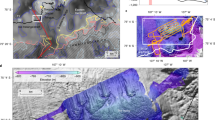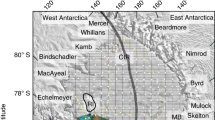Abstract
The Pope, Smith and Kohler glaciers, in the Amundsen Sea Embayment of West Antarctica, have experienced enhanced ocean-induced ice-shelf melt, glacier acceleration, ice thinning and grounding-line retreat in the past 30 years. Here we present observations of the grounding-line retreat of these glaciers since 2014 using a constellation of interferometric radar satellites combined with precision surface elevation data. We find that the grounding lines develop spatially variable, kilometre-scale, tidally induced migration zones. After correction for tidal effects, we detect a sustained pattern of retreat coincident with high melt rates of ungrounded ice, marked by episodes of more rapid retreat. In 2017, Pope Glacier retreated 3.5 km in 3.6 months, or 11.7 km yr–1. In 2016–2018, Smith West retreated at 2 km yr–1 and Kohler at 1.3 km yr–1. While the retreat slowed in 2018–2020, these retreat rates are faster than anticipated by numerical models on yearly timescales. We hypothesize that the rapid retreat is caused by unrepresented, vigorous ice–ocean interactions acting within newly formed cavities at the ice–ocean boundary.
This is a preview of subscription content, access via your institution
Access options
Access Nature and 54 other Nature Portfolio journals
Get Nature+, our best-value online-access subscription
$29.99 / 30 days
cancel any time
Subscribe to this journal
Receive 12 print issues and online access
$259.00 per year
only $21.58 per issue
Buy this article
- Purchase on Springer Link
- Instant access to full article PDF
Prices may be subject to local taxes which are calculated during checkout




Similar content being viewed by others
Data availability
All data needed to evaluate the conclusions in the paper are present in the paper and/or Supplementary Information. The CSK data (original COSMO-SkyMed product ASI, Agenzia Spaziale Italiana (2007–2020)) were provided by the Italian Space Agency (ASI) and the TDX data (original TanDEM-X product DLR (2007–2019)) by the German Space Agency (DLR). CSK data are publicly available through data grants from ASI. TanDEM-X CoSSC products were through scientific proposal OTHER0103 and are publicly available. Velocity (https://nsidc.org/data/NSIDC-0484/versions/2) and BedMachine (https://nsidc.org/data/NSIDC-0756/versions/2) data products are available as MEaSUREs products at the National Snow and Ice Data Center, Boulder CO (NSIDC). Geocoded interferograms, grounding-line positions, reference surface elevation, reference ice thickness, reference height above flotation and reference ice velocity are available at https://doi.org/10.7280/D1B114.
References
Shepherd, A. et al. Mass balance of the Antarctic Ice Sheet from 1992 to 2017. Nature 558, 219–222 (2018).
Rignot, E. et al. Four decades of Antarctic Ice Sheet mass balance from 1979–2017. Proc. Natl Acad. Sci. USA 116, 1095–1103 (2019).
Mouginot, J., Rignot, E. & Scheuchl, B. Sustained increase in ice discharge from the Amundsen Sea Embayment, West Antarctica, from 1973 to 2013. Geophys. Res. Lett. 41, 1576–1584 (2014).
Schoof, C. Marine ice sheet stability. J. Fluid Mech. 698, 62–72 (2012).
Scheuchl, B., Mouginot, J., Rignot, E., Morlighem, M. & Khazendar, A. Grounding line retreat of Pope, Smith, and Kohler glaciers, West Antarctica, measured with Sentinel-1a radar interferometry data. Geophys. Res. Lett. 43, 8572–8579 (2016).
Lilien, D. A., Joughin, I., Smith, B. & Shean, D. E. Changes in flow of Crosson and Dotson ice shelves, West Antarctica, in response to elevated melt. Cryosphere 12, 1145–1431 (2018).
Gourmelen, N. et al. Channelized melting drives thinning under a rapidly melting Antarctic ice shelf. Geophys. Res. Lett. 44, 9796–9804 (2017).
Khazendar, A. et al. Rapid submarine ice melting in the grounding zones of ice shelves in West Antarctica. Nat. Comm. 7, 13243 (2016).
Lilien, D. A., Joughin, I., Smith, B. & Gourmelen, N. Melt at grounding line controls observed and future retreat of Smith, Pope, and Kohler glaciers. Cryosphere 13, 2817–2834 (2019).
Konrad, H. et al. Net retreat of Antarctic glacier grounding lines. Nat. Geosci. 11, 258–262 (2018).
Milillo, P. et al. Heterogeneous retreat and ice melt of Thwaites Glacier, West Antarctica. Sci. Adv. 5, eaau3433 (2019).
Milillo, P. et al. On the short‐term grounding zone dynamics of Pine Island Glacier, West Antarctica, observed with COSMO‐SkyMed Interferometric Data. Geophys. Res. Lett. 44, 10436–10444 (2017).
Padman, L., Fricker, H. A., Coleman, R., Howard, S. & Erofeeva, L. A new tide model for the Antarctic ice shelves and seas. Ann. Glaciol. 34, 247–254 (2002).
Millan, R., Rignot, E., Bernier, V., Morlighem, M. & Dutrieux, P. Bathymetry of the Amundsen Sea Embayment sector of West Antarctica from operation IceBridge gravity and other data. Geophys. Res. Lett. 44, 1360–1368 (2017).
Morlighem, M. et al. Deep glacial troughs and stabilizing ridges unveiled beneath the margins of the Antarctic ice sheet. Nat. Geosci. 13, 132–137 (2019).
Miles, R. et al. Glider observations of the Dotson Ice Shelf outflow. Deep Sea Res. 2 123, 16–29 (2016).
An, L. et al. Bed elevation of Jakobshavn Isbræ, West Greenland, from high-resolution airborne gravity and other data. Geophys. Res. Lett. 44, 3728–3736 (2017).
Mouginot, J. et al. Fast retreat of Zachariæ Isstrøm, northeast Greenland. Science 350, 1357–1361 (2015).
An, L. et al. Ocean melting of the Zachariae Isstrom and Nioghalvfjerdsfjorden glaciers, northeast Greenland. Proc. Natl Acad. Sci. USA 118, e2015483118 (2021).
Howat, I. M., Joughin, I., Tulaczyk, S. & Gogineni, S. Rapid retreat and acceleration of Helheim Glacier, east Greenland. Geophys. Res. Lett. 32, 22 (2005).
Rignot, E., Mouginot, J., Morlighem, M., Seroussi, H. & Scheuchl, B. Widespread, rapid grounding line retreat of Pine Island, Thwaites, Smith, and Kohler glaciers, West Antarctica, from 1992 to 2011. Geophys. Res. Lett. 41, 3502–3509 (2014).
DeConto, R. M. & Pollard, D. Contribution of Antarctica to past and future sea-level rise. Nature 531, 591–597 (2016).
Dowdeswell, J. A. et al. Delicate seafloor landforms reveal past Antarctic grounding-line retreat of kilometers per year. Science 368, 1020–1024 (2020).
Yu, H., Rignot, E., Seroussi, H., Morlighem, M. & Choi, Y. Impact of iceberg calving on the retreat of Thwaites Glacier, West Antarctica over the next century with different calving laws and ocean thermal forcing. Geophys. Res. Lett. 46, 14539–14547 (2019).
van Wessem, J. M. et al. Modelling the climate and surface mass balance of polar ice sheets using RACMO2—part 2: Antarctica (1979–2016). Cryosphere 12, 1479–1498 (2018).
Rignot, E., Jacobs, S., Mouginot, J. & Scheuchl, B. Ice-shelf melting around Antarctica. Science 341, 266–270 (2013).
Joughin, I., Smith, B. E. & Medley, B. Marine ice sheet collapse potentially under way for the Thwaites Glacier Basin, West Antarctica. Science 344, 735–738 (2014).
Goldberg, D. N., Gourmelen, N., Kimura, S., Millan, R. & Snow, K. How accurately should we model ice shelf melt rates? Geophys. Res. Lett. 46, 189–199 (2019).
Seroussi, H. et al. Continued retreat of Thwaites Glacier, West Antarctica, controlled by bed topography and ocean circulation. Geophys. Res. Lett. 44, 6191–6199 (2017).
Seroussi, H. & Morlighem, M. Representation of basal melting at the grounding line in ice flow models. Cryosphere 12, 3085–3096 (2018).
Sayag, R. & Worster, M. G. Elastic dynamics and tidal migration of grounding lines modify subglacial lubrication and melting. Geophys. Res. Lett. 40, 5877–5881 (2013).
Tsai, V. C. & Gudmundsson, G. H. An improved model for tidally modulated grounding-line migration. J. Glaciol. 61, 216–222 (2015).
Begeman, C. B. et al. Tidal pressurization of the ocean cavity near an Antarctic ice shelf grounding line. J. Geophys. Res. Oceans 125, e2019JC015562 (2020).
Reese, R., Winkelmann, R. & Gudmundsson, H. Grounding-line flux formula applied as a flux condition in numerical simulations fails for buttressed Antarctic ice streams. Cryosphere 12, 3229–3242 (2018).
Rizzoli, P. et al. Generation and performance assessment of the global TanDEM-X digital elevation model. ISPRS J. Photogramm. Remote Sens. 132, 119–139 (2017).
Padman, L., King, M., Goring, D., Corr, H. & Coleman, R. Ice-shelf elevation changes due to atmospheric pressure variations. J. Glaciol. 49, 521–526 (2003).
Berrisford, P. et al. The ERA-Interim Archive Version 2.0 (ECMWF, 2011).
Acknowledgements
This work was conducted at the UC Irvine under a contract with the Cryosphere Program of NASA (17-CRYO17–0025, 80NSSC18M0083 and NNX17AI02G). E.R. acknowledges support from the NSF (F0691-04).
Author information
Authors and Affiliations
Contributions
P.M. set up the CSK Antarctica experiment and acquisition plans and processed and analysed the CSK data. P.R., P.P.-I. and J.L.B.-B. processed the TDX time-tagged DEMs. P.M. and E.R. interpreted the results and wrote the manuscript. L.D. provided support with the CSK data. All authors reviewed the manuscript.
Corresponding author
Ethics declarations
Competing interests
The authors declare no competing interests.
Peer review
Peer review information
Nature Geoscience thanks David Lilien and the other, anonymous, reviewer(s) for their contribution to the peer review of this work. Primary Handling Editor: Tom Richardson.
Additional information
Publisher’s note Springer Nature remains neutral with regard to jurisdictional claims in published maps and institutional affiliations.
Supplementary information
Supplementary Information
Supplementary Figs. 1–6 and Tables 1 and 2.
Rights and permissions
About this article
Cite this article
Milillo, P., Rignot, E., Rizzoli, P. et al. Rapid glacier retreat rates observed in West Antarctica. Nat. Geosci. 15, 48–53 (2022). https://doi.org/10.1038/s41561-021-00877-z
Received:
Accepted:
Published:
Issue Date:
DOI: https://doi.org/10.1038/s41561-021-00877-z
This article is cited by
-
Short- and long-term variability of the Antarctic and Greenland ice sheets
Nature Reviews Earth & Environment (2024)
-
How rapidly can ice sheets retreat?
Nature (2023)
-
Sea level rise from West Antarctic mass loss significantly modified by large snowfall anomalies
Nature Communications (2023)
-
Rapid, buoyancy-driven ice-sheet retreat of hundreds of metres per day
Nature (2023)
-
Investigation of initiation conditions of periglacial debris flows in Sanggu watershed, Eastern Himalayas, Tibet Plateau (China)
Landslides (2023)



